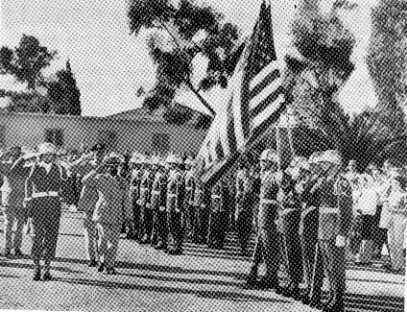
| Kagnew Station is a United States military
radio receiving and transmitting facility
located since 1942 at Asmara on the Ethiopian
highlands. Its 7,600 foot altitude, and
location close to the relatively interference-free equatorial belt, gives Kagnew Station
unique technical advantages as the Aftrican-Middle East element in the world-wide system
linking United States communications
facilities in Europe, Asia and the Western
Hemisphere.
For many reasons, including the mutual
friendship and trust existing between the
Ethiopian and American peoples, Kagnew's
character as a technical communications
facility, its employment of large numbers of
Ethiopian citizens, its open-door policy
towards visitors, and its continuing
community relations activities, Kagnew
Station has enjoyed excellent relations with
the people and the Government of its host
country. As an invited guest, Kagnew Station
functions in Ethiopia at the sovereign choice
of an Ethiopian nation possessing one of the
longest and proudest rraditions of
independence on the African or any other
continent.
Kagnew Station comprises several tracts of land in the Asmara area, rented by the United States Government from the Imperial Ethiopian Government. The entire area is about 3,400 acres, of which only about 300 acres are leased for exclusive use by the U.S. Government. The remaining land, only partly occupied by radio antennas, is open to continued use for agricultural and grazing purposes, under conditions amounting to 25 percent U.S. use. The rental paid for the land is used by the Ethiopian authorities to com- |
pensate any affected farmer for crops lost or
damaged.
Seven tracts serve as sites for transmitting and
receiving equipment. An eighth site (Tract E)
comprises the Station Headquarters, with
supporting facilities including living quarters,
dependents' school, hospital, post exchange,
commissary, recreation activities and
entertainment facilities. A ninth area (Tract
A) has additional family housing and
recreational facilities.
Kagnew Station has no combat aircraft,
artillery, tanks, missiles or other offensive
weapons. Some small arms necessary for the
internal security of the installation are the only
weapons at the facility. The military
complement of Kagnew is made up of
communications technicians, backed up by
administrative and support personnel.
The American community in the Asmara area
amounts to approximately four to five
thousand people, including military,
dependents and other government personnel.
The U.S. radio communications facility at
Asmara was originally established as part of
the Allied war effort against the Axis
folloowing defeat of Italian forces occupying
Ethiopia in April, 1941. The name "Kagnew"
was chosen for its significance in Ethiopia's
historic struggle for freedom. The word
Kagnew (in its Ethiopian pronunciation,
kanyew) means "to bring into harmony" or "to
bring order out of chaos."
|
... Its Background
| Kagnew came into modern Ethiopian history
at the Battle of Adua (Adowa) in 1896.
Kagnew was the name of the Ethiopian
commanding general's horse; this horse, the
story is told, galloped riderless towards the
attacking Italians, heartening the Ethiopian
troops into repulsing the invaders. In 1935,
when Ethiopia was again invaded by Italian
forces, an Ethiopian military aircraft nick-named Kagnew conducted heroic and
damaging raids against the Italian forces.
After the 1941 liberation, the name Kagnew was bestowed on an Ethiopian Army battalion, manned by picked personnel and considered to be the best in the nation. In 1951, the Kagnew Battalion was sent to Korea as a part of Ethiopia's support of the United Nations and distinguished itself in the field. |
Because of its relatively isolated location,
Kagnew Station has existed since its founding
as an almost completely self-contained village,
supplied by plans landing at the Asmara
airport and ships docking at Massawa. Some
of the facilities available at the post for the
welfare of its personnel include:
* An interdenominational chapel with a
seating capacity of 220 and overflow space to
accommodate 150 more persons. In additon,
other chapel sponsored activities are
conducted. (See page 21)
* Modern multi-floor barracks and apartment units are used to house satation personnel. A guest house and kitchen is used for transient guests. (See page 13) |
| His Imperial Majesty Haile Selassie I, Emperor of Ethiopia, regularly visits Kagenw Station. Appropriate salutes are rendered during an inspection of the Honor Guard | |
| |
| |
| The Main Gate at Kagnew Station is an Asmara land-mark, where courteous members of the Military Police are on duty to render assistance | |
| * A 346-seat motion picture theatre equipped
with Cinemascope screen and latest sound and
projection equipment shows five files weekly.
(See page 23)
* A diversified athletic program can be conducted at a large post gymnasium, which has a ten-lane bowling alley, and multiple court facilities. (See page 23) * A dependent school providing classes for children of kindergarten age plus grades one through twelve. About 500 children attend the school. * A combined laundry and dry-cleaning plant with modern new equipment. * An Armed Forces Radio and Televion Service outlet -- KANU radio and KANU-TV. (See page 18) * The finance Office provides such services as cashing money orders, government checks, and selling Treasury Checks for cash in |
amounts over $100. The Kagnew Station
Credit Union also provides a place for
savings, and sells American Express checks.
* Other important facilities include a mess hall
with a special area for senior-noncommissioned officers, veterinary service,
post exchange and snack bars, commissary,
service club, craft shop, library and auto
hobby shop, athletic fields, indoor swimming
pool and clubs for officers, non-commissioned
officers and enlisted men.
The men and dependents of Kagnew Station -- as well as other Americans in Ethiopia -- are served by the United Stations Embassy in Addis Ababa and the Consulate in Asmara. Other U.S. Government agencies or activities in Ethiopia include the U.S. Information Service (which operates an excellent library in Asmara), U.S. Agency for International Development, (A.I.D), a Military Assistance Advisory Group, and Peace Corps. |
Return to Table of Contents
Last Updated February 4, 1998 by James Boyce